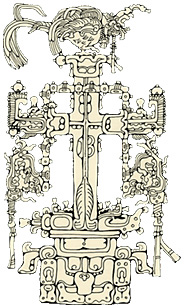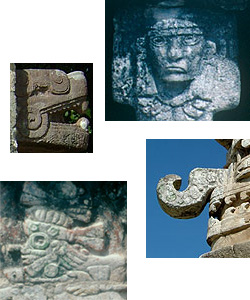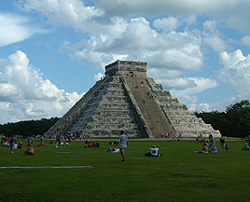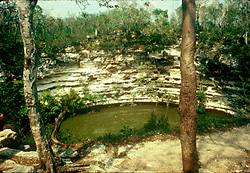|
MAYAN MYTHOLOGY
 The World Tree image recurs throughout Mayan cities, both in wall carvings and in paintings. Look down at the smooth, green lawn out of which the Pyramid springs like a great tree. For the Maya, this lawn and others may have been a re-creation of the first sea, and El Castillo may be a manifestation of the tree itself. These patterns recur in Mayan cities again and again: the smooth sea of grass and the sudden uplifting of a great building that draws the eye and mind up to the sky.
The World Tree image recurs throughout Mayan cities, both in wall carvings and in paintings. Look down at the smooth, green lawn out of which the Pyramid springs like a great tree. For the Maya, this lawn and others may have been a re-creation of the first sea, and El Castillo may be a manifestation of the tree itself. These patterns recur in Mayan cities again and again: the smooth sea of grass and the sudden uplifting of a great building that draws the eye and mind up to the sky.
 In Mayan iconography, buildings such as El Castillo may have also been representative of the mountain monsters. It’s thought that mountains were sacred to the ancient Maya: Some people believe that images of volcanic mountains were seen as portals to the creative and destructive forces of the gods. The Mayan creation myth includes reference to a first mountain, the source of all food and sustenance for the first people. These mountain images have the faces of monsters, and they appear near to the images of kings, linking them to the forces of creation, possibly implying that the kings were rulers of these forces, masters of death and bringers of life.
In Mayan iconography, buildings such as El Castillo may have also been representative of the mountain monsters. It’s thought that mountains were sacred to the ancient Maya: Some people believe that images of volcanic mountains were seen as portals to the creative and destructive forces of the gods. The Mayan creation myth includes reference to a first mountain, the source of all food and sustenance for the first people. These mountain images have the faces of monsters, and they appear near to the images of kings, linking them to the forces of creation, possibly implying that the kings were rulers of these forces, masters of death and bringers of life.
 Descend the northern stairs of El Castillo, which will lead you directly to the great northern causeway. This is the ceremonial pathway to a hidden focus point, the limestone sinkhole known as the
Sacred Cenote
. The deep limestone caves contain wells brimming with cold, dark water. The wells that dot the Yucatan forests may have been viewed by the Maya as portals to the other world, known as
Xibalba
. The holes into the watery earth may have been seen as passages back to the time of the beginning, before the sky was lifted above the sea, a time when gods debated and fought in the watery other world.
Descend the northern stairs of El Castillo, which will lead you directly to the great northern causeway. This is the ceremonial pathway to a hidden focus point, the limestone sinkhole known as the
Sacred Cenote
. The deep limestone caves contain wells brimming with cold, dark water. The wells that dot the Yucatan forests may have been viewed by the Maya as portals to the other world, known as
Xibalba
. The holes into the watery earth may have been seen as passages back to the time of the beginning, before the sky was lifted above the sea, a time when gods debated and fought in the watery other world.
 As watery tunnels into the dark earth,
cenotes
may have been places of power in Mayan thought. It's believed that the Maya used some wells for water, taking sustenance for human life. But some, like the large Sacred Cenote at Chichén Itzá, may have been used as receptacles for treasure and human sacrifices. These portals may also have been seen as two-directional: Sustenance flowed from the god world into the human world, and the Maya provided the gods with sustenance as well.
As watery tunnels into the dark earth,
cenotes
may have been places of power in Mayan thought. It's believed that the Maya used some wells for water, taking sustenance for human life. But some, like the large Sacred Cenote at Chichén Itzá, may have been used as receptacles for treasure and human sacrifices. These portals may also have been seen as two-directional: Sustenance flowed from the god world into the human world, and the Maya provided the gods with sustenance as well.
|

